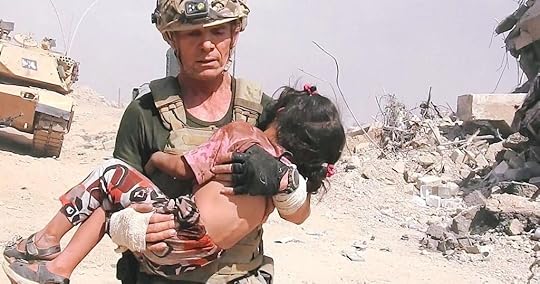What do you think?
Rate this book


336 pages, Hardcover
First published January 3, 2017
Derek B. Miller - The author is the founder of The Policy Lab, an international think tank and has worked for the United Nations Institute for Disarmament Research
David Eubank, an aid worker and former Green Beret runs through ISIL gun fire to rescue a girl in Mosul, Iraq on June 16th, 2017
We get some great insights into the world of humanitarian aid workers like Marta and the way the Arabic speaking world can be alienated by the West’s good intentions…..’Marta needs a cigarette now. She does not have one. And so she holds her Bic fountain pen as though it is the cigarette that she ought to have. She is sitting on an orange chair at a white table, listening to a briefing provided by a Swiss-based research organisation concerning affairs in eastern Syria that might affect operations in northern Iraq. It is early evening, and she is already tired.
The researcher is young – late twenties. She has blonde hair and eyes that speak of her excitement at being part of something darker than herself, as though proximity to horror somehow might strengthen her own character. In most cases, though, it’s the opposite. It unravels us. But Marta isn’t about to explain this to her.
The girl began her presentation, some thirty minutes ago, by quoting Thierry Lefebvre’s 1927 article ‘Le vilayet de Mossoul’, telling everyone that ‘Ninawa is no longer Iraq and not yet Kurdistan’. This remains true, Marta thinks, but as a piece of analysis, sort of leaves you hanging. The girl then seemed to prove Marta’s point – and not her own – by focussing the rest of her talk on change and the future rather than on continuity and the past, which was the West’s first error over here…………….
Marta’s national staff once explained to her – after she insisted that their annual report be translated into Arabic for the first time – that almost none of these words (e.g. peace-building, civil liberties, conflict sensitivity, confidence-building measures, resilience, social cohesion) have homologues in Arabic. In fact, the ideas themselves are so foreign and often irrelevant that Arabic speakers, in speaking to one another, simply insert the English term into their conversation. This happens directly in front of Western diplomats, who are oblivious to its significance.
Arwood Hobbes is the most outspoken and arguably the most unlikeable of the characters in the book. He received an ‘other than honourable discharge’ from the army in the Gulf War and is disgruntled, disenfranchised, any number of dis- words, and has a chip on his shoulder and plenty of attitude. In this scene he is talking to Jamal, a local man who is their driver, and Jamal attempts to explain how some of the locals are feeling…..’No one wants to be weak anymore. They are tied of being weak. They want to return to a time when they were strong and united. They cannot stand the humiliation anymore. The West does not understand our humiliation.
Arwood replies..’And you think that if these people felt proud and respected, they’d stop packing ice-cream trucks with explosives to kill as many children as possible? They need jobs and a hug?’
‘I’m saying there are reasons.’
‘There are always reasons Jamal, but not justifications. Listen, I’ve been watching these douchebags for years. These guys aren’t choosing between a job in auto mechanics and beheading infidels. Yeah, they’re discontented, and maybe they’ve got a good reason too. Fair enough. The thing is, there are a lot of hard-luck cases in the world, and a lot of places on the losing side of history. But not all those places celebrate mass murder because they’re angry. See, little Johnny Hardluck might feel bad one day and say to his mummy, ‘Mummy, I feel so bad I’m going to cut somebody’s head off.’ That could happen in Pittsburgh. We have psychos, too. But how Mummy responds is kind of what makes one place different from another. So if his mummy says, ‘That’s a good idea, Johnny, you slice them up real good, and if you die, we’ll be extra proud of you,’ then we know what kind of people we’re dealing with. Around here, you kill a hundred children with an exploding ice-cream truck, and your family gets a pension and its own website. That doesn’t happen in Pittsburgh. That is not a minor distinction. When we act badly, we at least feel really bad about it, and try to find ways to avoid it later. These people do exactly the opposite. That’s why we’re better than them. Got it?’
‘They are being manipulated by the elites.’
‘Jamal, you can only manipulate ideas that make sense to people already. If an imam gets on his soapbox and tells all the Sunnis to go out and kill all the New York Yankee fans, they wouldn’t make much headway. Because it wouldn’t make any kind of sense. Go kill the Shiites? That makes sense. Unfortunately everything happening down the mountain, and even up here, makes sense to people, whether they like it or not…..It’s like this Jamal: we will never get along with anyone – not now, not later, not ever – if their mamas don’t dance and their daddies don’t rock and roll. Because it’s mind over matter, my friend. And you cannot change people’s minds about what matters.’